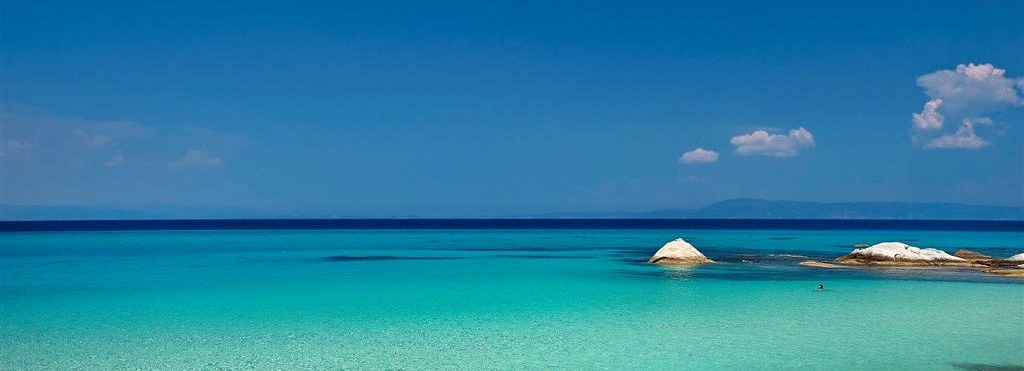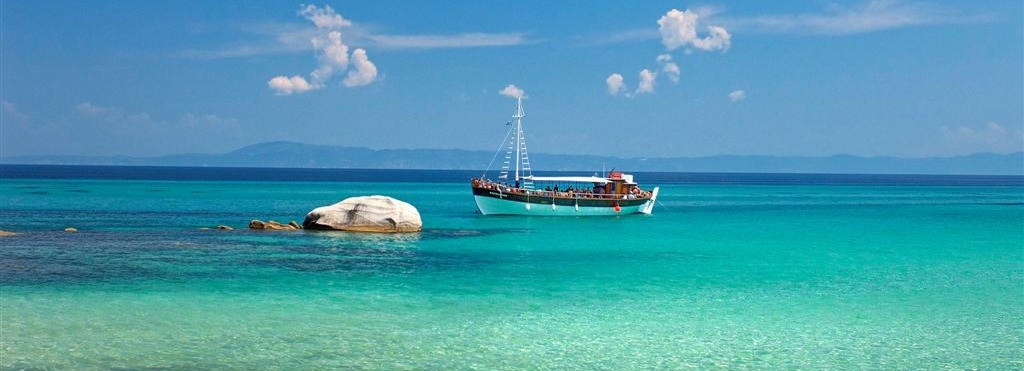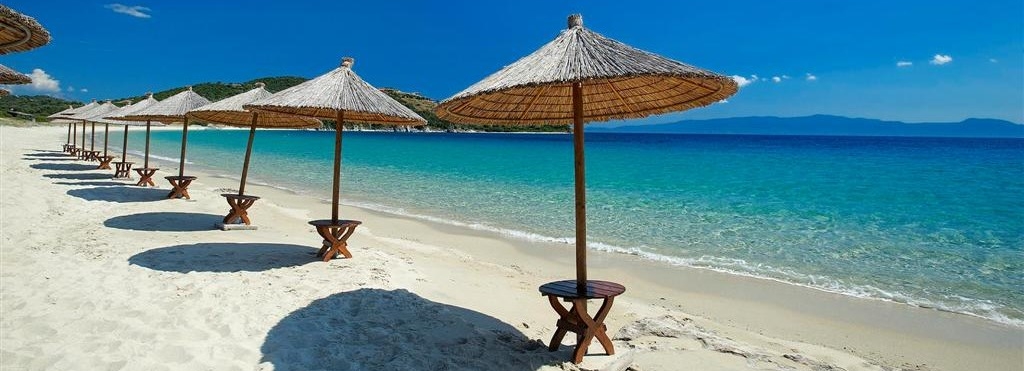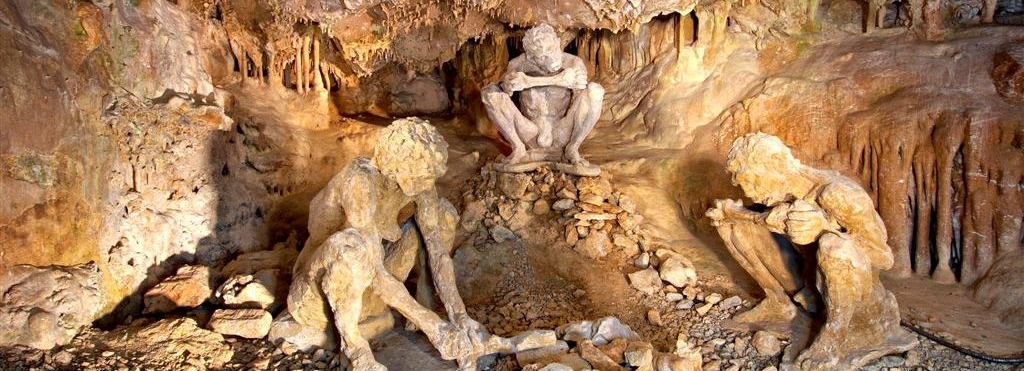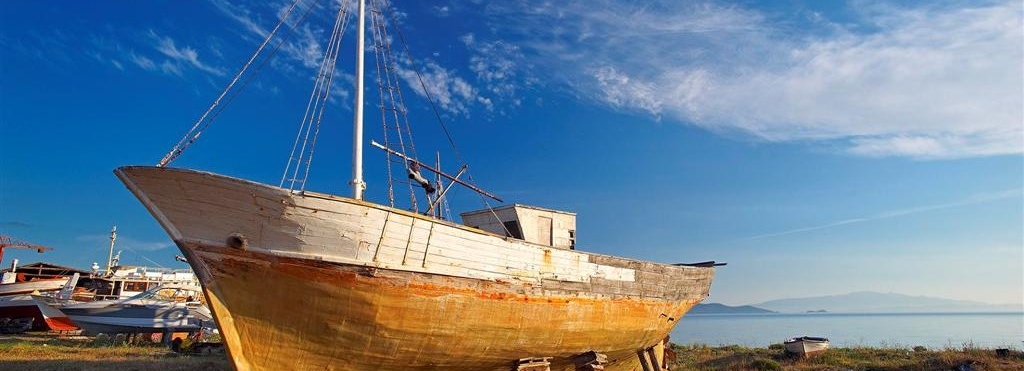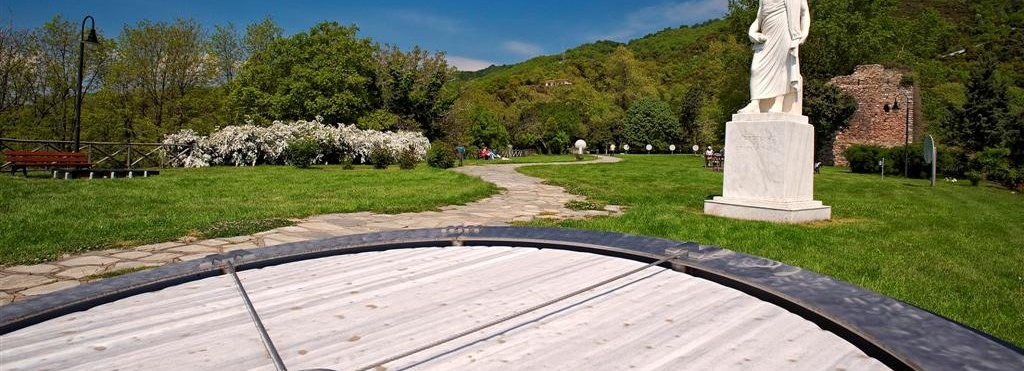On the southwestern wing of the complex of the Skete of St. Andrew near Karyes operates today the Athonias Ecclesiastical Academy, or Athonite Academy. The Academy was inaugurated in 1749, following an initiative by Patriarch Cyril the V. It had originally been housed in a building constructed specially for this on a hill near Vatopedi monastery. That complex included of 170 cells, Refectory, Chapel, Library and teaching halls. It was a highest educational academy under the corresponding Patriarchic Sigil. St. Cosmas of Aetolia and Athanasius Parios had both graduated and taught there. It ceased to operate in 1809 and reopened its doors in St. Andrew’s Skete as an ecclesiastical academy and orphanage in 1930.
Athonias Ecclesiastical Academy
Tel. 23770-23200 Fax 23770-23341
Dafni is Karyes’ heaven. In ancient times it was the sanctuary for Apollo of Danfi. Around 1044 the monastery of Docheiario was established here, but it soon was deserted due to frequent pirate raids and subsequently moved to its present day location. Throughout Mt. Athos’ history, Dafni was and continues to be a key reference point for the movement of both pilgrims and monks. The only bus in Mt. Athos leaves from Dafni to follow the route to Karyes and the bay of the monastery of Iviron. The small settlement of Dafni is comprised of various public buildings, serving the pilgrims such as the port authority, customs office, post office, police precinct and other buildings housing a restaurant, a hotel, groceries, where one can also find ecclesiastic goods and souvenirs, as well as warehouses and laymen houses. Most of the buildings in Dafni date from the 19th century, a period where there was frequent arrivals of ships, mainly from Russia. Recently due to the increased needs, the old pier was widened and a second one was constructed. Most of Dafni belongs to the territory of Xiropotamou monastery, while its southern part belongs to Simonos Petra. The border between these two monasteries is a natural canal where the mountainous torrents used to empty their waters. The beautiful verdurous slopes which rise from the bay combined with the colors of the sea, paint a very tranquil ambiance, disrupted only during the disembarkation of pilgrims and goods.
The church of Protaton is the oldest Catholicon in Mt. Athos and is dedicated to the Dormition of the Virgin. It was probably erected during the first half of the 10th century, renovated in the era of Andronicus Palaeologos, while restoration works were also undertaken in 1955, where a square was created in the place of the cells adjacent to Protaton, to promote the latter. It differs from the Catholicon of the monasteries on Mt. Athos in being a triple-aisled basilica with an elevated middle aisle, that permits the third row of openings on its perimeter. Its present day form combines the type of the basilica, with respect to its roof, with a cross shaped ground plan. Its interior stands out for four pessaries divide the cross-shaped church into a central space with corner rooms. The church is adorned with awe inspiring frescoes, dating from the 14th century, and painted by Manuel Panselinos, the key representative artist of the Macedonian School, while its icon screen, or templon, is marble and a well preserved expression of old Byzantine icon screens. Kept on the synthronon in the Holy Bema is the miracle working icon “Axion Esti”, which dates, according to tradition, back to the 10th century and is the symbol of the Holy Mountain. The church has two narthexes which date from the early 16th century, one on its western side in the form of a adit and another on its northern side, where there is a cenotaph for the monks who were slaughtered by Catalan pirates in the 14th century. The bell tower was erected in 1534 by Seraphim and later renovated. In the tower of Protaton there is a library with 117 manuscripts, of which 47 are parchments. Kept in its archive room is the 1st Typikon (liturgical book) for Mt. Athos by Emperor John Tzimiskes, also known as “billy goat” for it is written on billy goat skin and constitutes the most historic text in this land.
Roughly in the middle of the peninsula of Athos and on its northern side we find Karyes, the amphictyonian center of the monastic state. This settlement is built in a verdurous environment. Its prime reference point is the church of Protaton, dating from the 10th century, the icon of Axion Esti and Panselinos’ frescoes, the tower of the church, the building of the Holy Community, nineteen houses (delegacies) of the monasteries, for all of them except for the one closest to Karyes, the monastery of Koutloumousio. Here one can also find the Governor’s building, subsumed to the Greek Ministry of Foreign Affairs (http://www.mfa.gr/ ), a Police Station, an Infirmary, Post and Telegram Office, a tailor shop, a bookstore, groceries and other shops and workshops. There are more than 50 cells in the greater area of Karyes, many of which are of particular historic importance, such as that of the Ravdouhos, a cell dating from the 10th century, and of Fournas. Karyes were founded in the 9th century when many monks moved in the area establishing Lavra in Karyes. Lavra in Karyes was acknowledged the first amongst all monasteries at that time and its Prior was named Protos (the First) in the Holy Mountain. During the Ottoman rules and dictated by the prevailing conditions most of the land and attachments of Lavra in Karyes and Protos were transferred to the other monasteries on Mt. Athos. Today these institutions are preserved in the form of the Holy Community and Holy Administration, led by the Head Custodian. The monks constituting the Holy Community are the representative of the twenty monasteries – and reside in Karyes.
FOURTEENTH MONASTERY
Near Dionysiou monastery, on the west side of Athos and close to the sea, inside an impressive gorge formed by the tall adjacent peaks we find Agiou Pavlou Monastery. According to tradition, the monastery was erected at the end of the 10th century by Paul of Xeropotamou, contemporary of St. Athanasius the Athonite, a spiritual man and hermit, the founder of Xeropotamou monastery. It is possible that Saint Paul retired from Xeropotamou monastery in some small cell in the area that gradually evolved to Agiou Pavlou monastery. The monastery will follow its own course and two centuries after its foundation, and possibly due to its desolation, will be demoted to a cell, thus losing the title of the cardinal monastery. In 1370 it will be relinquished to two Serbian monks, Gerasimus and Antonius who will painstakingly restore it back to its former dominant place. From then on and until the Ottoman rule the monastery will be assisted by Byzantine Emperors and Despots, as well as Serb rulers. Among its benefactors we also find Christian Princess Mara, daughter of Branković, wife of Ottoman Sultan Murad II and mother of the conqueror of Constantinople, Mehmed II. Mara who kept, despite her marriage, true to her Christian faith, will donate money and dependencies to the monastery and later, after Constantinople fell, will bestow the gifts of the three magi upon the monastery, a holy relic and Turkish loot from the fall. The history of the monastery follows closely that of the other monasteries. It will suffer hard from raids and heavy taxation during the Ottoman rule. It will also succumb to fires and floods, all of which will bring it to a desperate financial state. The monastery will find solidarity in the rulers and believers of the countries on the banks of Danube and the greater space of Hellenism, who supported it financially and assisted it in expanding its building installations. The library of the monastery is home to 508 manuscripts, 14.000 printed volumes and several golden bulls, led bulls and patriarchic sigils. Worth noting amongst its many heirlooms are a piece of the True Cross, part of the gifts by the Biblical Magi and various icons, of great historic and artistic value. Its Catholicon venerates the Presentation of Chris at the Temple and celebrates on the 2nd of February.
THIRTEENTH MONASTERY
The monastery stands 300 meters above the sea on a huge rock, on the southeastern coast of Athos peninsula, just past the port of Danfi, Mt. Athos’ most daring building. Simonos Petra, or Simonopetra (literally “Simon’s Rock”), monastery was founded by Simon the Athonite who was a monk in Athos in the 13th century and initially named the monastery “New Bethlehem”. The monastery’s key and principal benefactor was Serbian despot Jovan Ugljesa, who in 1362AD funded the renovation and expansion of the monastery. The monastery was hit hard by fires in 1580 and 1622 and as a result was in total desolation in early 17th century. In 1762 Russian monk Paisius Velichkovsky stayed in the ruins of the monastery and attempted, assisted by other monks, to revive the monastery. Paisius’ stay might has been brief but his work was continued by monk Joasaf from Mytilene. Simonopetra, after having succumbed to becoming idiorrhythmic, the monastery will return to cenobitic organization in 1801, but after enduring the hard years of the Turkish occupation of Mt. Athos, from 1821 to 1830, it was completely destroyed by fire in May 1891. With financial aid from Russia the monastery and its Catholicon were build once more and, despite such frequent catastrophes, Simonopetra flourishes spiritually yet once more with the arrival of new monks from Meteora. The architectural layout of its buildings, due to the limited space, is very different from other monasteries on Mt. Athos. The Catholicon of the monastery is dedicated to the Birth of Christ. Its treasures include pieces of the True Cross, vests, crosses pectoral crosses, icons and many relics from Saints, such as the left hand of St. Mary Magdalene, the foot of St. Dionysus and the head of Holy Martyr Sergius, which bears a small cicatrix due to a strike suffered as he was tortured.
TWELFTH MONASTERY
Three hundred meters above sea level and half an hour from Karakalou Monastery, amidst a verdurous landscape on the eastern side of Mount Athos there lies one of the oldest monasteries on Mt. Athos, Filotheou Holy Monastery. Tradition mentions that the monastery was built by Blessed Philotheos, contemporary of St. Athanasius, before 972 and was then known as Fteri Monastery. Among the monastery’s benefactors in its first years were Emperor Nikephorus Boteneates and later other Byzantine Emperors of the Palaeologos dynasty. In the 13th century, Serb king Stephen Uros Dusan, known for his help to Athos’ monasteries, will also assist Filotheou Monastery. As a result of this help a great number of monks in the monastery during that era were Serbs. One of the strongest personalities to have served as monks in Philotheou was Abbot Dionysus, in early 16th century, who later founded Dionysus Monastery “on Olympus”. Its benefactors in the 17th and 18th century included the Tsar of Russia Michael and the Greek princes of Danubian provinces, who supported the monastery and allowed monks to run collections in order to raise money. A permanent cause for dispute between Philotheou and Megiste Lavra monasteries were the Cells of Milopotamos and Kravatos, which were contested by both monasteries. Finally at the end of the 16th century and by means of patriarchic sigils these were awarded to Lavra. One of the most important figures of Orthodox monasticism comes from Philotheou monastery, Cosmas of Aetolia. Upon leaving the monastery, Cosmas taught the Gospel to enslaved Greeks, before he martyred in the hands of the Turks in August 1779. In 1900 the Monastery finds itself in a tight financial spot once more, only to be assisted by the Holy Community this time, thus subjecting itself to its custody. From the most remarkable treasures of the monastery is the icon of Our Lady Glykofilousa , which, tradition has it, reached Mount Athos on its own, to escape the wrath of iconoclasm, and the hand of St. John Chrysostom, a gift by Andronicus II Palaeologos. The Refectory is illustrated by Hagiographer Tzortzis from Crete in 1540. The Catholicon of the monastery is dedicated to the Annunciation of the Mother of God and 12 cells build in the surrounding area and a further two in Karyes are subject to the monastery.
ELEVENTH MONASTERY
Between the monasteries of Megiste Lavra and Iviron and at an altitude of roughly 200 meters above sea level one can find one of the oldest monasteries on Mt. Athos, the Holy Monastery Karakallou. The monastery appears in Athonite documents and Typikon since the early 11th century, the period when its foundation is suggested. But according to the tradition of Mt. Athos, its foundation must be placed much earlier. Based on its name, such traditions hold that its founder was Roman Emperor Marcus Aurellius, also known as Karakallas, who reigned in early 3rd century AD. But the monastery is clearly posterior. With respect to its name, this might be attributed to some monk or Abbot by the name Karakallas, a common byzantine name in that era. This monastery also shared the common fate of the monasteries on Mt. Athos. A period of flourishing was followed, in 1204, by Latin Rule and just after the pogroms by Unificationist Michael VIII. The destruction will be completed by the Catalan raids in early 14th century. Despite such frequent catastrophes, the number of monks living in the monastery will grow, while it will also acquire dependencies and attachments. Important was the help by Vlach ruler Ioannis Petros, who will take his monastic vows there. In the revolution of 1821 Karakallou Monastery will play an active part and after the ten year occupation by the Turks it will become, in late 19th century, a place of quiet for Russian monks. A fire in 1875 destroyed a major part of the monastery, but its Catholicon, a work of the 16th century, survived. It library is home to 300 manuscripts, of which 42 are parchments, as well as 3.000 printed volumes. Its treasures and heirlooms include pieces of the True Cross, pectoral crosses, crosses, Saint’s relics, with the most important being those of Saint Gedeon, who martyred in Tyrnovo, Bulgaria. The monastery celebrates Apostles Peter and Paul. Its Catholicon was erected in 1548 and was illustrated in early 18th century. Its icon screen is adorned with the exquisite icon of the 12 Apostles, a work by monk Dionysius from Agrafa, dated 17222.
TENTH MONASTERY
On the west side of Mt. Athos and at an altitude of 30 meters above sea level, between the monasteries of Xenophon and Zografou we find the monastery of Dochiariou. Tradition mentions that this holy monastery was founded by monk Euthymius, student of Blessed Athanasius Athonite. Euthymius after becoming a monk and manciple at Lavra founded this new monastery on the southwestern side of Athos, a monastery which took its name from its founder deaconship. The monastery is cited in documents from Mt. Athos in early 11th century, while its course resembles that of other monasteries. After a period of flourishing, during the 11th and 12th centuries, it will suffer from pirate raids and the pogroms by the Latin invaders and those in favor of the Unification of Churches. This period of decline will be interrupted in middle 16th century, when Father George from Adrianople became a monk in this almost deserted monastery and devoted his life to its restoration. He was assisted in this great project by prince of Moldova-Wallachia Alexander and his wide Roxandra, who donated considerable amounts of money and estates, thus lending a new lease of life to the monastery. Father George was also assisted by the Metropolite of Moldova Theofanis, who, at the end of his life, resigned from office and lived there as an anchorite. The Catholicon of the monastery is dedicated to Archangels Michael and Gabriel. Amongst the ten chapels in the monastery’s courtyard prominent is the chapel of Our Lady Gorgoipekoos with the homonymous miracle working icon, one of the most celebrated icons in all Mt. Athos. Due to the courtyard’s limited space, the Catholicon of the monastery is elevated and a work dating back to the 16th century. It was illustrated in 1568 by Cretan painter Tzortzis but was repainted in 1855, thus depriving us of an important part of its original frescoes.
NINTH MONASTERY
Built in late 10th century, the Holy Monastery Zografou is one of the oldest on Mt. Athos. It is secluded deep in the forest at an altitude of 160 meters, one hour away from the beach and near a gorge. According to tradition it was founded by three brother-monks, whose descent was from the area of Achrida: Moses, Aaron and Ioannis, who took their monastic vows on Holy Mt. Athos in the 9th century, during the reign of Emperor Leon VI the Wise. Various documents cite the existence of the monastery from late 10th century onwards. Its fate was that of many other cardinal monasteries, a period of flourishing followed, in the 13th century, by a period of hardship and destruction , principally due to the pirate raids, while later, during the reign of Michael VIII Palaeologos and Andronicus a second period of flourishing is observed. Its monks were prosecuted during the reign of Michael VIII, known for his pro-Unification policy, when Patriarch Ioannis Beccus was at the Patriarchic Throne. The monks of Zografou fiercely opposed the Emperor and Patriarch’s unification attempts and tradition mentions that 26 of them, who stayed true to Orthodoxy, were tortured and martyred in February 1276, while the monastery was burned. In the 14th century the monastery will benefit from the assistance by princes of the Danubian Provinces and especially Stephen V Voivod of Moldova-Wallachia and Stephen VI the “Good” who will renovate is Refectory in 1495. Since its foundation the monastery has a tradition of accepting monks from Bulgaria, a tradition that continues until today. Its Catholicon celebrates Great Martyr St. George and has 14 chapels, of which 3 are illustrated. The church was build and illustrated in late 18th century. Special note must be made of its woodcut icon screen and altar, prime examples of woodcutting on Mt. Athos. The library of the monastery is located in the Tower and possess 550 manuscript codices of which 162 in Greek and 388 in Slavic. It also includes of more than 17.000 printed volumes. Its treasures include relics of Saints and miracle working icons, as well as historic documents of great value. Still surviving in the area of the monastery is the hut where Cosmas of Aetolia the Great apostle of our nation and holy martyr led an ascetic’s life.
More...
EIGHTH MONASTERY
To the east of the monastery of Agios Panteleimon and to the west of that of Simonopetra, at a distance of roughly 200 meters from the sea in the middle of the southwestern side of the peninsula of Athos and amidst a verdurous landscape we find the beautiful, imposing and cardinal monastery of Xiropotamou, at the place of once ancient Charadria. Its foundation is essentially placed at the end of the 9th century, just prior to the erection of the monastery of Megiste Lavra. But the Athonian tradition holds that this monastery is even older, attributing its foundation to Empress Pulcheria, in the 5th century AD. Other sources cite Emperors Constantine VI Porphyrogennetus and Romanus I Lecapenus as the monastery’s founders, in early 10th century. But the most widely accepted version is that which considers the monastery to have been founded by monk Blessed Paul of Athos, a contemporary of Blessed Athanasius Athonite. The original name of the monastery was “the monastery of the Holy Forty” but also of “St. Nicephorus”. Up until the 13th century the Monastery prospered and evolved, but was later faced with destruction from pirate raids and fires. However it was greatly assisted by Emperors Michael VII and Andronicus II and was also favored by Sultan Selim I, According to tradition monks from Xiropotamou, or Xeropotamou whilst on tour to collect money to help rebuild their destroyed monastery were welcomed by the Ottoman Sultan Selim I in Alexandria in Egypt. Selim, in his campaign against Egypt was impressed by the faith and morale of the monks from Mt. Athos and issued a special instrument, the Hati-Serif by which special privileges were extended to all monasteries on Mt. Athos and especially to the monastery Xiropotamou which he also restored. The Catholicon of the monastery celebrates the Forty Holy Martyrs.
SEVENTH MONASTERY
The Holy Monastery Pantokratoros is built on a rock beaten by the sea, on the eastern side of the Mountain, thirty meters above the sea. The establishment of the monastery had taken place in the 13th century and two Byzantine noble officials are considered to be its founders. One of them was General Alexios, Stratopedarchis of Emperor John V Paleologos and the other was primikerios John, the Emperor’s bridegroom. According to tradition, these two men came to Athos to become monks in a small cell which later will evolve into this cardinal monastery. The initial development of the monastery will be followed by a period of economic crisis, which will become even harder during Ottoman rule. The support by the rulers of the countries on the banks of Danube and Russian Emperors will help the monastery greatly, but it will suffer from fires, the fiercest of which was that in 1773. One of the key attachments of the Monastery is the Skete of Prophet Elijah, which was founded by Russian monk Paisius Velichkovsky, who came to the Holy Mountain in 1757 at the age of 24. The Skete will evolve upon the arrival of a great number of Russian monks and will be organized in accordance to cenobitic living, in essence assuming the size and importance of a monastery. The evolution of the Skete of Prophet Elijah and the erection of new buildings without the consent of the cardinal monastery of Pantokratoros raised a legal issue in the relationship between the two institutions, an issue that was resolved in 1892 by a sigillium by Patriarch Neophytus. The monastery celebrates on the Transfiguration of our Savior and holds the seventh place in the Athonian monastic hierarchy. The Catholicon of the monastery, due to lack of space, is small and its frescoes are a prime example of the work of Macedonian School. The most important treasures of the monastery include the portable icon of Our Lady Gerontissa, a piece of the shield of Philopater Mercurius, a piece of the True Cross and the relics of many Saints. Its library contains 317 manuscripts, of which 68 on parchment and roughly 5.000 printed volumes. Due to the lack of space the Refectory is not housed in a separate building, but is located on the uppermost floor of the west wing of the monastery’s buildings.
SIXTH MONASTERY
Southwest of Karyes and on the northeastern side of Mt. Athos, amidst the giant trees and in the verdurous hills there is the Koutloumousiou Monastery. The history of the Monastery begun in the 11th or 12th century AD, while a document dated 1169AD already cites its existence. Tradition mentions that the founder of the monastery was a Turk nobleman named Koutloumous, who having been converted to Christianity, founded the monastery and became a monk on Mt. Athos. The monastery shall pass some hard times and then receive the final blow in early 14th century, when it shall be raided by the fierce Catalan pirates. Thus, before the grave economic problems facing the monastery, Protos Isaac will cede to it, for purposes of reinforcement, in 1334 the monasteries of Stavronikita, Prophet Elijah, Anapavsa and Philalelfou. Aspiring to develop the monastery once more, in the middle 14th century, vigorous Abbot Chariton of Imbros shall travel to the lands on the banks of Danube to seek help from their rulers. One of the greatest benefactors to emerge from this quest was Romanian John Vladislav, who will support the monastery considerably. Strong ties were forged with Romania and the monastery shall become the exercise grounds for many Romanian devotees. In early 15th century the Monastery will further flourish, also due to the large number of monks, and it shall request of Patriarch Josef II to annex the deserted monastery of St. Alypius, a request that was granted in 1428 by virtue of a Patriarchal sigillum. It was at this time that the monastery reached its heyday, a period that will be followed by decline and destruction, from fires in 1497 and 1767. The Patriarch of Alexandria Matthaios II, having resigned from the throne, will help with the rebuilding of the destroyed wings. New fires will again destroy parts of the monastery in 1857, 1870 and more recently in 1980. The Catholicon of the Monastery which is dedicated to the Transfiguration of the Savior, is richly illustrated and the icon of the “Mighty Protection” of Our Lady is kept in one of its small chapels. The Skete of Agios Panteleimon is subject to the Koutloumousiou Monastery.
FIFTH MONASTERY
High above the sea, on a narrow rock on the southwestern side of Athos, Saint Dionysus from Kastoria embarked in 1370AD on the grand design of establishing a new monastery. The initial group of supporters and assistants to this project were just his students, later to be joined by Emperor Alexios III Komnenos who will endow a considerable sum and an annual grand to the monastery. It is for this reason that the monastery was originally known as the “Monastery of Great Komnenos”, until the name of its founder prevailed and it thus became known as the Monastery of St. Dionysios. This policy of substantial aid was continued by the Dynasty of Paleologoi and later, during Ottoman rule, by several rulers in Moldova-Wallachia. The monastery will suffer extensive damages from a great fire in 1535 which will destroy its Catholicon. But a number of new benefactors, in the 17th century, will allow the monastery to rebuild the destroyed wings and to continue its operation. Amongst these important new benefactors some, like the Bishop of Heraklia Makarios and Ioannis Fragopoulos from Fanari will also serve as monks, dedicating themselves, as well as their fortune to the monastery. Due to its limited space, the monastery differs greatly from most monasteries on Mt. Athos. The great courtyard is here absent, as is the Phial. The monastery has many treasures and a great Library with manuscripts and printed volumes. Its treasures include the portable icon of Our Lady Akathistos. Tradition has it that this was the icon which Patriarch of Constantinople Sergius carried in procession on the walls of Constantinople during its siege by the Avars and the Slavs in 626AD. Its Catholicon celebrates the Birth of John the Baptist and is adorned by wonderful frescoes by Cretan Hagiographer Tzortzis, dating from 1547. Its library contains roughly 1.100 manuscripts, while some codices are decorated with splendid miniature paintings. Amongst the monastery’s many treasures there are Gospels, Crosses, pectoral crosses, woven vests, exquisite reliquaries, portable icons and many others.
